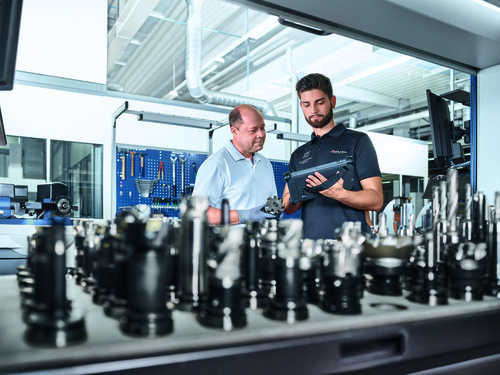ระบบบริหารการจัดการทูลหรือเครื่องมือ ( Tool management ) กำลังทวีความสำคัญเพิ่มมากขึ้น บริษัทส่วนใหญ่ต้องการข้อมูลที่โปร่งใสและกระบวนการทำงานที่มีประสิทธิภาพ รวมทั้งยังต้องการทราบว่า ต้นทุนที่แท้จริงนั้นมาจากจุดใดและจะลดต้นทุนดังกล่าวลงได้อย่างไรในระยะยาว
MEGA Tech ยินดีนำเสนอ Tool Management Cockpit ศูนย์กลางการจัดการเครื่องมือจาก Walter ซึ่งนำมาใช้เป็นระบบมาตรฐานกับโครงสร้างการบริหารจัดการจัดการทูลหรือเครื่องมือทั้งหมดของ Walter ซึ่งจะช่วยสร้างคุณค่าเพิ่มให้แก่ลูกค้าได้มากขึ้น โดยไม่มีค่าใช้จ่ายใดๆเพิ่มเติมในส่วนของลูกค้า

โดยเป้าหมายหลักของระบบการบริหารจัดการทูลหรือเครื่องมือ ( Tool mangment ) คือการสร้างความโปร่งใส 100% ให้กับกระบวนการจัดการเครื่องมือผ่านทางความร่วมมือกับลูกค้า ดังนั้น เพื่อให้สามารถบรรลุเป้าหมายนี้ได้ Walter จึงรับบทบาทเป็นจุดศูนย์กลางการประสานงานสำหรับห่วงโซ่กระบวนการทั้งหมด ตั้งแต่การจัดหาระบบเครื่องมือไปจนถึงการรีไซเคิลเครื่องมือใช้แล้ว ซึ่งเป็นการสร้างวงจรการทำงานรูปแบบใหม่ที่ให้ประสิทธิภาพได้ในระดับสูงสุด นอกจากจะให้ข้อมูลเกี่ยวกับต้นทุนในการจัดซื้อแล้ว ยังช่วยให้เห็นถึงต้นทุนการผลิตที่เกิดขึ้นด้วยเช่นกัน หรือที่เรียกว่า ต้นทุนต่อชิ้นงานที่ผลิตได้ (Cost Per Produced Part หรือ CPP) ซึ่งเป็นการเปิดประตูโอกาสใหม่ๆ เพื่อให้สามารถปรับปรุงประสิทธิภาพการผลิตได้อย่างทันท่วงที นอกจากนี้ Tool Management Cockpit ยังสามารถบอกได้อีกว่า วิธีใดจะช่วยให้ประหยัดต้นทุนได้มากที่สุดระหว่างการปรับปรุงประสิทธิภาพของขั้นตอนการตัดเฉือนหรือการออกแบบขั้นตอนการตัดเฉือนใหม่ทั้งหมด
ออกแบบเพื่อการทำงานของลูกค้าโดยเฉพาะ
ธุรกิจการผลิตโดยทั่วไปจะใช้ระบบ ERP เดียวกันทั้งองค์กร ซึ่งเป็นตัวกำหนดว่าแต่ละกระบวนการจะมีขั้นตอนอย่างไร โดยจะเน้นไปที่กระบวนการผลิตเป็นหลัก เนื่องจากเป็นส่วนงานที่สร้างผลกำไรให้แก่บบริษัท และจุดนี้เองที่ Tool Management Cockpit จาก Walter สามารถเข้ามามีบทบาท เพราะระบบนี้ถูกออกแบบมาให้สามารถปรับให้เหมาะกับกระบวนการทำงานของลูกค้าได้ โดยที่ลูกค้าไม่ต้องปรับเปลี่ยนอะไรในส่วนของตนเอง โดยซอฟต์แวร์นี้จะเน้นเฉพาะในส่วนของการบริหารคลังสินค้าและห่วงโซ่อุปทานเป็นหลัก ลูกค้าสามารถที่จะส่งต่องานทั้งหมดที่เกี่ยวข้องกับกระบวนการผลิต เช่น การจัดหาเครื่องมือและการปรับปรุงประสิทธิภาพการผลิต โดย Walter จะทำหน้าที่รับผิดชอบงานทั้งหมดในด้านการจัดหาจำนวนเครื่องมือที่เหมาะสมในแต่ละขั้นตอน หรือแม้แต่สำหรับแต่ละชิ้นงาน

Tool Management Cockpit จาก Walter ทำหน้าที่เป็นเสมือนศูนย์กลางในการควบคุมและแลกเปลี่ยนข้อมูลที่ได้จากระบบต่างๆ ที่เกี่ยวข้อง ข้อมูลที่จำเป็นสำหรับการวิเคราะห์ต่างๆ สามารถนำมาจากระบบอื่นๆ ได้เช่นกันผ่านทางอินเตอร์เฟสที่มีอยู่ ตัวอย่างเช่น การนำตู้จ่ายเครื่องมือมารวมไว้ในระบบ เพื่อ “ติดตาม” เครื่องมือ เช่น บันทึกข้อมูลว่าใครเป็นผู้นำเครื่องมือออกมา นำออกมาเมื่อไร และนำไปใช้ทำงานอะไร อย่างไรก็ตาม ข้อมูลนี้เพียงอย่างเดียวอาจไม่ถือเป็นข้อมูลเชิงลึก เนื่องจากไม่สามารถระบุได้ว่า เครื่องมือดังกล่าวถูกนำไปใช้ผลิตชิ้นงานใด การแก้ปัญหานี้สามารถทำได้โดยใช้ระบบ Tool·ID ซึ่งช่วยให้สามารถกำหนดได้ว่า เครื่องมือจะถูกนำไปใช้กับงานตัดเฉือนงานใดงานหนึ่งหรือหลายงาน เป็นต้น จากนั้น ซอฟต์แวร์ Tool Management Cockpit จะทำหน้าที่ในการวิเคราะห์และประมวลผลข้อมูลดังกล่าวในขั้นต่อไป

สะดวกต่อการใช้งาน
อินเตอร์เฟสผู้ใช้ของซอฟต์แวร์มีการออกแบบที่เรียบง่ายโดยเน้นความสะดวกในการใช้งาน โดยใช้การออกแบบในลักษณะเดียวกับโปรแกรม Office ที่ผู้ใช้คุ้นเคยดีอยู่แล้ว เช่น Excel และ PowerPoint รวมทั้งยังสามารถปรับเปลี่ยนฟังก์ชั่นการใช้งานต่างๆ ได้ตามความต้องการของแต่ละผู้ใช้ และทำการป้อนและแก้ไขชุดข้อมูลต่างๆ ได้อย่างสะดวก Tool Management Cockpit จะสร้างรายงานสถิติเกี่ยวกับสต๊อกเครื่องมือ ปริมาณการใช้ และต้นทุนชิ้นงานในปัจจุบัน พร้อมทั้งแสดงจุดสั่งซื้อเพิ่มที่แนะนำ รวมถึงข้อมูลเกี่ยวกับปริมาณการใช้เครื่องมือเฉลี่ยในแต่ละวัน ข้อมูลต่างๆ เหล่านี้ช่วยให้สามารถระบุระยะเวลาที่เหมาะสมในการสั่งซื้อเครื่องมือเพิ่มเติมครั้งต่อไป รวมทั้งยังช่วยให้สต๊อกเครื่องมืออยู่ในปริมาณที่เหมาะสมที่สุด นอกจากนี้ ข้อมูลภาพรวมจากซอฟต์แวร์จะแสดงคำสั่งซื้อคงค้างและคำสั่งซื้อที่ส่งมอบแล้วสำหรับเครื่องมือแต่ละรายการ หรือกดแค่ปุ่มเดียวเพื่อให้ Tool Management Cockpit แสดงข้อมูลว่า กำลังมีการใช้เครื่องมือใดเพื่อผลิตชิ้นงานใดอยู่ในปัจจุบัน หรือแสดงต้นทุนรวมที่เกิดขึ้นภายในกรอบระยะเวลาที่เลือก
ฟังก์ชั่นคำนวณ CPP (ต้นทุนต่อชิ้นงาน) ถือเป็นอีกหนึ่งคุณสมบัติที่น่าสนใจเป็นพิเศษ และเป็นหัวใจสำคัญในการลดต้นทุนการดำเนินงาน โดยจะให้ข้อมูลเกี่ยวกับสถานะการตรวจสอบและการลดต้นทุน ซอฟต์แวร์ Tool Management Cockpit ยังสามารถสร้างรายงาน CPP ตามเวลาจริงได้ รวมถึง สัดส่วนต้นทุนของแต่ละเครื่องมือ พร้อมทั้งการเปรียบเทียบระหว่างต้นทุนเป้าหมาย-ต้นทุนจริงของเครื่องมือ ภาพรวมของคำสั่งซื้อจะให้ข้อมูลอย่างละเอียดเกี่ยวกับสถานะของการสั่งซื้อสินค้าแต่ละรายการจากซัพพลายเออร์แต่ละราย Tool Management Cockpit ยังโดดเด่นด้วยความสามารถในการวางแผนและควบคุมการปรับปรุงประสิทธิภาพ โดยจะแสดงทางเลือกที่เป็นไปได้ต่างๆ พร้อมทั้งต้นทุนที่ประหยัดได้ของแต่ละทางเลือก
เงื่อนไขสำหรับการเก็บรวบรวมข้อมูลดังกล่าวคือ จะต้องสามารถระบุเครื่องมือแต่ละชิ้นได้ วิธีที่จะทำเช่นนี้ได้นั้นไม่มีอะไรยาก โดยสามารถบันทึกข้อมูลด้วยตนเองหรือโดยใช้ระบบ Tool ID, RFID หรือเทคโนโลยีการระบุเครื่องมือรูปแบบอื่นๆ ซึ่งจะช่วยให้สามารถทำซ้ำ แสดง และให้ข้อมูลของกระบวนการต่างๆ ในการผลิตได้อย่างเที่ยงตรงแม่นยำ ดังนั้น จึงสามารถตรวจหากระบวนการที่ยังขาดประสิทธิภาพและดำเนินมาตรการแก้ไขได้อย่างรวดเร็ว Walter จะให้คำแนะนำและเปรียบเทียบวิธีแก้ไขต่างๆ รวมทั้งดำเนินการแก้ไขหลังจากที่ปรึกษาร่วมกับลูกค้าแล้ว ซึ่งทุกบริการเหล่านี้ คุณจะได้รับจากผู้ให้บริการหนึ่งเดียวแบบครบวงจร
Article by: Walter (Thailand) Co., Ltd.
www.walter-tools.com/en-gb/pages/defau << Click Here












